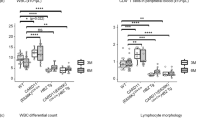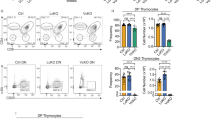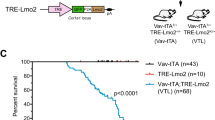Abstract
The most common translocation in childhood T-cell acute lymphoblastic leukemia (T-ALL) involves the LMO2 locus, resulting in ectopic expression of the LMO2 gene in human thymocytes. The LMO2 gene was also activated in patients with X-linked Severe Combined Immune Deficiency treated with gene therapy because of retroviral insertion in the LMO2 locus. The LMO2 insertions predisposed these children to T-ALL, yet how LMO2 contributes to T cell transformation remains unclear. The LIM (Lin 11, Isl-1, Mec-3) domain containing LMO2 protein regulates erythropoiesis as part of a large transcriptional complex consisting of LMO2, TAL1, E47, GATA1 and LDB1 that recognizes bipartite E-box-GATA1 sites on target genes. Similarly, a TAL1/E47/LMO2/LDB1 complex is observed in human T-ALL and Tal1 and Lmo2 expression in mice results in disease acceleration. To address the mechanism(s) of Tal1/Lmo2 synergy in leukemia, we generated Lmo2 transgenic mice and mated them with mice that express wild-type Tal1 or a DNA-binding mutant of TAL1. Tal1/Lmo2 and MutTAL1/Lmo2 bitransgenic mice exhibit perturbations in thymocyte development due to reduced E47/HEB transcriptional activity and develop leukemia with identical kinetics. These data demonstrate that the DNA-binding activity of Tal1 is not required to cooperate with Lmo2 to cause leukemia in mice and suggest that Lmo2 may cooperate with Tal1 to interfere with E47/HEB function(s).
This is a preview of subscription content, access via your institution
Access options
Subscribe to this journal
Receive 50 print issues and online access
$259.00 per year
only $5.18 per issue
Buy this article
- Purchase on Springer Link
- Instant access to full article PDF
Prices may be subject to local taxes which are calculated during checkout





Similar content being viewed by others
References
Abraham N, Miceli MC, Parnes JR, Veillette A . (1991). Enhancement of T-cell responsiveness by the lymphocyte-specific tyrosine protein kinase p56lck. Nature 350: 62–66.
Aoyama M, Ozaki T, Inuzuka H, Tomotsune D, Hirato J, Okamoto Y et al. (2005). LMO3 interacts with neuronal transcription factor, HEN2, and acts as an oncogene in neuroblastoma. Cancer Res 65: 4587–4597.
Aplan PD, Jones CA, Chervinsky DS, Zhao X, Ellsworth M, Wu C et al. (1997). An scl gene product lacking the transactivation domain induces bony abnormalities and cooperates with LMO1 to generate T-cell malignancies in transgenic mice. Embo J 16: 2408–2419.
Bain G, Engel I, Robanus Maandag EC, te Riele HP, Voland JR, Sharp LL et al. (1997). E2A deficiency leads to abnormalities in alphabeta T-cell development and to rapid development of T-cell lymphomas. Mol Cell Biol 17: 4782–4791.
Berg T, Cohen SB, Desharnais J, Sonderegger C, Maslyar DJ, Goldberg J et al. (2002). Small-molecule antagonists of Myc/Max dimerization inhibit Myc-induced transformation of chicken embryo fibroblasts. Proc Natl Acad Sci USA 99: 3830–3835.
Boehm T, Foroni L, Kennedy M, Rabbitts TH . (1990). The rhombotin gene belongs to a class of transcriptional regulators with a potential novel protein dimerisation motif. Oncogene 5: 1103–1105.
Clackson T, Wells JA . (1995). A hot spot of binding energy in a hormone-receptor interface. Science 267: 383–386.
Davenport J, Neale GA, Goorha R . (2000). Identification of genes potentially involved in LMO2-induced leukemogenesis. Leukemia 14: 1986–1996.
Ferrando AA, Neuberg DS, Staunton J, Loh ML, Huard C, Raimondi SC et al. (2002). Gene expression signatures define novel oncogenic pathways in T cell acute lymphoblastic leukemia. Cancer Cell 1: 75–87.
Fisch P, Boehm T, Lavenir I, Larson T, Arno J, Forster A et al. (1992). T-cell acute lymphoblastic lymphoma induced in transgenic mice by the RBTN1 and RBTN2 LIM-domain genes. Oncogene 7: 2389–2397.
Garcia IS, Kaneko Y, Gonzalez-Sarmiento R, Campbell K, White L, Boehm T et al. (1991). A study of chromosome 11p13 translocations involving TCR beta and TCR delta in human T cell leukaemia. Oncogene 6: 577–582.
Goardon N, Lambert JA, Rodriguez P, Nissaire P, Herblot S, Thibault P et al. (2006). ETO2 coordinates cellular proliferation and differentiation during erythropoiesis. Embo J 25: 357–366.
Greenbaum S, Zhuang Y . (2002). Regulation of early lymphocyte development by E2A family proteins. Semin Immunol 14: 405–414.
Hacein-Bey-Abina S, Garrigue A, Wang GP, Soulier J, Lim A, Morillon E et al. (2008). Insertional oncogenesis in 4 patients after retrovirus-mediated gene therapy of SCID-X1. J Clin Invest 118: 3132–3142.
Hacein-Bey-Abina S, von Kalle C, Schmidt M, Le Deist F, Wulffraat N, McIntyre E et al. (2003a). A serious adverse event after successful gene therapy for X-linked severe combined immunodeficiency. N Engl J Med 348: 255–256.
Hacein-Bey-Abina S, Von Kalle C, Schmidt M, McCormack MP, Wulffraat N, Leboulch P et al. (2003b). LMO2-associated clonal T cell proliferation in two patients after gene therapy for SCID-X1. Science 302: 415–419.
Herblot S, Steff AM, Hugo P, Aplan PD, Hoang T . (2000). SCL and LMO1 alter thymocyte differentiation: inhibition of E2A-HEB function and pre-T alpha chain expression. Nat Immunol 1: 138–144.
Howe SJ, Mansour MR, Schwarzwaelder K, Bartholomae C, Hubank M, Kempski H et al. (2008). Insertional mutagenesis combined with acquired somatic mutations causes leukemogenesis following gene therapy of SCID-X1 patients. J Clin Invest 118: 3143–3150.
Hsu HL, Wadman I, Tsan JT, Baer R . (1994). Positive and negative transcriptional control by the TAL1 helix-loop-helix protein. Proc Natl Acad Sci USA 91: 5947–5951.
Hsu LY, Lauring J, Liang HE, Greenbaum S, Cado D, Zhuang Y et al. (2003). A conserved transcriptional enhancer regulates RAG gene expression in developing B cells. Immunity 19: 105–117.
Huang EY, Gallegos AM, Richards SM, Lehar SM, Bevan MJ . (2003). Surface expression of Notch1 on thymocytes: correlation with the double-negative to double-positive transition. J Immunol 171: 2296–2304.
Huang S, Brandt SJ . (2000). mSin3A regulates murine erythroleukemia cell differentiation through association with the TAL1 (or SCL) transcription factor. Mol Cell Biol 20: 2248–2259.
Kelliher MA, Seldin DC, Leder P . (1996). Tal-1 induces T cell acute lymphoblastic leukemia accelerated by casein kinase IIalpha. Embo J 15: 5160–5166.
Krosl G, He G, Lefrancois M, Charron F, Romeo PH, Jolicoeur P et al. (1998). Transcription factor SCL is required for c-kit expression and c-Kit function in hemopoietic cells. J Exp Med 188: 439–450.
Kussie PH, Gorina S, Marechal V, Elenbaas B, Moreau J, Levine AJ et al. (1996). Structure of the MDM2 oncoprotein bound to the p53 tumor suppressor transactivation domain. Science 274: 948–953.
Lahlil R, Lecuyer E, Herblot S, Hoang T . (2004). SCL assembles a multifactorial complex that determines glycophorin A expression. Mol Cell Biol 24: 1439–1452.
Larson RC, Lavenir I, Larson TA, Baer R, Warren AJ, Wadman I et al. (1996). Protein dimerization between Lmo2 (Rbtn2) and Tal1 alters thymocyte development and potentiates T cell tumorigenesis in transgenic mice. Embo J 15: 1021–1027.
Lecuyer E, Herblot S, Saint-Denis M, Martin R, Begley CG, Porcher C et al. (2002). The SCL complex regulates c-kit expression in hematopoietic cells through functional interaction with Sp1. Blood 100: 2430–2440.
Nam CH, Lobato MN, Appert A, Drynan LF, Tanaka T, Rabbitts TH . (2008). An antibody inhibitor of the LMO2-protein complex blocks its normal and tumorigenic functions. Oncogene 27: 4962–4968.
O'Neil J, Billa M, Oikemus S, Kelliher M . (2001). The DNA binding activity of TAL-1 is not required to induce leukemia/lymphoma in mice. Oncogene 20: 3897–3905.
O'Neil J, Shank J, Cusson N, Murre C, Kelliher M . (2004). TAL1/SCL induces leukemia by inhibiting the transcriptional activity of E47/HEB. Cancer Cell 5: 587–596.
Ono Y, Fukuhara N, Yoshie O . (1997). Transcriptional activity of TAL1 in T cell acute lymphoblastic leukemia (T-ALL) requires RBTN1 or -2 and induces TALLA1, a highly specific tumor marker of T-ALL. J Biol Chem 272: 4576–4581.
Rabbitts TH . (1994). Chromosomal translocations in human cancer. Nature 372: 143–149.
Ryan DP, Duncan JL, Lee C, Kuchel PW, Matthews JM . (2008). Assembly of the oncogenic DNA-binding complex LMO2-Ldb1-TAL1-E12. Proteins 70: 1461–1474.
Schlaeger TM, Schuh A, Flitter S, Fisher A, Mikkola H, Orkin SH et al. (2004). Decoding hematopoietic specificity in the helix-loop-helix domain of the transcription factor SCL/Tal-1. Mol Cell Biol 24: 7491–7502.
Sharma VM, Calvo JA, Draheim KM, Cunningham LA, Hermance N, Beverly L et al. (2006). Notch1 contributes to mouse T-cell leukemia by directly inducing the expression of c-myc. Mol Cell Biol 26: 8022–8031.
Valge-Archer VE, Osada H, Warren AJ, Forster A, Li J, Baer R et al. (1994). The LIM protein RBTN2 and the basic helix-loop-helix protein TAL1 are present in a complex in erythroid cells. Proc Natl Acad Sci USA 91: 8617–8621.
Visvader JE, Venter D, Hahm K, Santamaria M, Sum EY, O'Reilly L et al. (2001). The LIM domain gene LMO4 inhibits differentiation of mammary epithelial cells in vitro and is overexpressed in breast cancer. Proc Natl Acad Sci USA 98: 14452–14457.
Wadman I, Li J, Bash RO, Forster A, Osada H, Rabbitts TH et al. (1994). Specific in vivo association between the bHLH and LIM proteins implicated in human T cell leukemia. Embo J 13: 4831–4839.
Wadman IA, Osada H, Grutz GG, Agulnick AD, Westphal H, Forster A et al. (1997). The LIM-only protein Lmo2 is a bridging molecule assembling an erythroid, DNA-binding complex which includes the TAL1, E47, GATA-1 and Ldb1/NLI proteins. Embo J 16: 3145–3157.
Wells JA . (1996). Binding in the growth hormone receptor complex. Proc Natl Acad Sci USA 93: 1–6.
Wells JA, de Vos AM . (1996). Hematopoietic receptor complexes. Annu Rev Biochem 65: 609–634.
Xu Z, Huang S, Chang LS, Agulnick AD, Brandt SJ . (2003). Identification of a TAL1 target gene reveals a positive role for the LIM domain-binding protein Ldb1 in erythroid gene expression and differentiation. Mol Cell Biol 23: 7585–7599.
Yan W, Young AZ, Soares VC, Kelley R, Benezra R, Zhuang Y . (1997). High incidence of T-cell tumors in E2A-null mice and E2A/Id1 double-knockout mice. Mol Cell Biol 17: 7317–7327.
Acknowledgements
This work is supported by an NIH/NCI CA096899 Grant to MK. Core resources supported by the Diabetes Endocrinology Research Center Grant DK32520 were also used.
Author information
Authors and Affiliations
Corresponding author
Ethics declarations
Competing interests
The authors declare no conflict of interest.
Rights and permissions
About this article
Cite this article
Draheim, K., Hermance, N., Yang, Y. et al. A DNA-binding mutant of TAL1 cooperates with LMO2 to cause T cell leukemia in mice. Oncogene 30, 1252–1260 (2011). https://doi.org/10.1038/onc.2010.495
Received:
Revised:
Accepted:
Published:
Issue Date:
DOI: https://doi.org/10.1038/onc.2010.495
Keywords
This article is cited by
-
TAL1 hijacks MYCN enhancer that induces MYCN expression and dependence on mevalonate pathway in T-cell acute lymphoblastic leukemia
Leukemia (2023)
-
Oncogenic transcriptional program driven by TAL1 in T-cell acute lymphoblastic leukemia
International Journal of Hematology (2019)
-
PADI4 acts as a coactivator of Tal1 by counteracting repressive histone arginine methylation
Nature Communications (2014)
-
LIM-domain-only proteins in cancer
Nature Reviews Cancer (2013)



